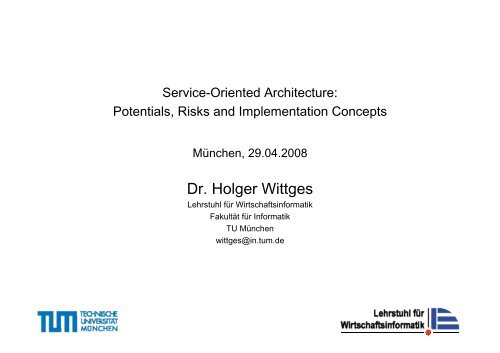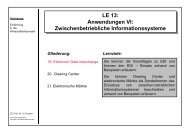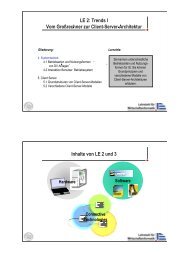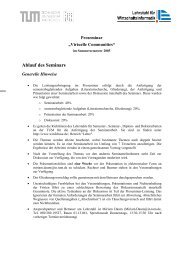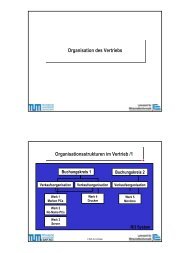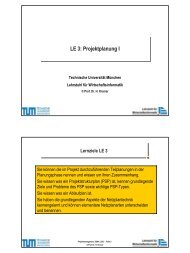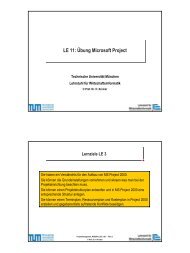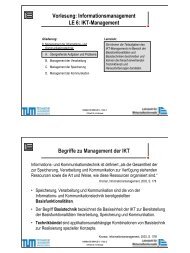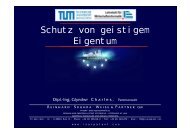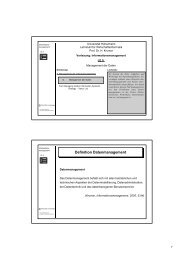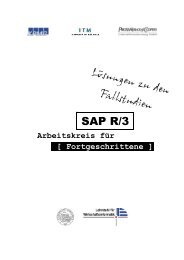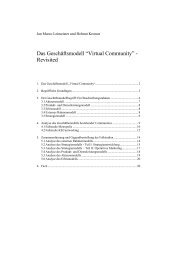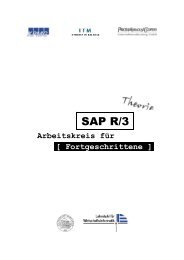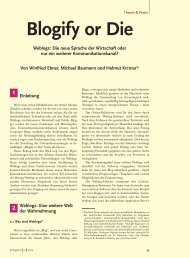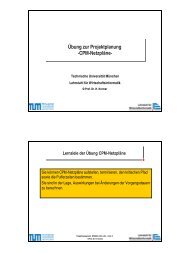Dr. Holger Wittges - Lehrstuhl für Wirtschaftsinformatik
Dr. Holger Wittges - Lehrstuhl für Wirtschaftsinformatik
Dr. Holger Wittges - Lehrstuhl für Wirtschaftsinformatik
You also want an ePaper? Increase the reach of your titles
YUMPU automatically turns print PDFs into web optimized ePapers that Google loves.
Service-Oriented Architecture:<br />
Potentials, Risks and Implementation Concepts<br />
München, 29.04.2008<br />
<strong>Dr</strong>. <strong>Holger</strong> <strong>Wittges</strong><br />
<strong>Lehrstuhl</strong> <strong>für</strong> <strong>Wirtschaftsinformatik</strong><br />
Fakultät <strong>für</strong> Informatik<br />
TU München<br />
wittges@in.tum.de
„Today's typical IT architectures are barriers<br />
for fast developing business.“<br />
Diaz-Rohr, 2004<br />
© <strong>Dr</strong>. H. <strong>Wittges</strong> - Folie 2 von 32
CEOs worldwide -Top 10 Challenges Overall<br />
Quelle: The Conference Board CEO Challenge 2004<br />
© <strong>Dr</strong>. H. <strong>Wittges</strong> - Folie 3 von 32
CEO worldwide: Top 5 Challenges overall<br />
1. Sustained and steady top-line growth 52%*<br />
2. Speed, flexibility, adaptability to change 42%<br />
3. Customer loyalty / retention 41%<br />
4. Stimulating innovation / creativity / enabling<br />
entrepreneurship 31%<br />
5. Cost / ability to innovate 29%<br />
* cite challenge as being “of greatest concern”<br />
Source: The Conference Board CEO Challenge 2004, based on 500 CEO feedbacks<br />
© <strong>Dr</strong>. H. <strong>Wittges</strong> - Folie 4 von 32
What is a Service-Oriented Architecture?
Service Oriented Architecture (SOA)<br />
• A Service-Oriented Architecture<br />
(SOA) is a way of designing a<br />
software system and its<br />
surrounding environment to<br />
provide services either to enduser<br />
applications, to executable<br />
business processes or to other<br />
services through published and<br />
discoverable service interfaces.<br />
Company A<br />
Application A<br />
ObjectA<br />
-----------------------------<br />
-----------------------------<br />
----------------------------<br />
---------------------------<br />
Discover<br />
Service<br />
Broker<br />
Publish<br />
Service<br />
Interface<br />
Application B<br />
ObjectB<br />
------------<br />
------------<br />
------------<br />
------------<br />
• New? No<br />
• Rocket science? Not really<br />
• A change in thinking? Most<br />
definitely!<br />
• Can you run right out and buy<br />
one? Well…<br />
Company B<br />
Source: http://www.eforceglobal.com/ppt/eFORCE_SOA_Webcast_Master.ppt, Access date 07/01/2007<br />
© <strong>Dr</strong>. H. <strong>Wittges</strong> - Folie 6 von 32
The key abstractions of a SOA<br />
SOA<br />
Applicationfrontend<br />
Service<br />
Service<br />
repository<br />
Service<br />
bus<br />
Contract<br />
Implementation<br />
Interface<br />
Business<br />
logic<br />
Data<br />
Based on: (Krafzig, Blanke et al. 2004)<br />
© <strong>Dr</strong>. H. <strong>Wittges</strong> - Folie 7 von 32
Key features of SOA<br />
• Key features of SOA as described by Erl (Erl 2005) are:<br />
• Self-describing<br />
• Locatable<br />
• Roughly structured<br />
• Loosely linked<br />
• Reusable<br />
• Enterprise SOA extends (own understanding)<br />
• business services<br />
• inter-organizational collaboration<br />
© <strong>Dr</strong>. H. <strong>Wittges</strong> - Folie 8 von 32
SOA != SOA<br />
Business Process Platform<br />
Business Process<br />
Business Service<br />
Application Service<br />
Application Function<br />
SOA 1<br />
SOA 2<br />
SOA 3<br />
SOA 4<br />
© <strong>Dr</strong>. H. <strong>Wittges</strong> - Folie 9 von 32
SOA Potentials
SWOT analysis: SOA<br />
Strengths: Strengths:<br />
•• SOA SOA is is based based on on established established Software- Software-<br />
Engineering Engineering principles principles<br />
•• Basic Basic SOA SOA principles principles are are easy easy to to undrestand undrestand<br />
•• High High acceptance acceptance of of the the SOA-Paradigm<br />
SOA-Paradigm<br />
•• functional functional driven driven approach approach<br />
•• scalability scalability and and protection protection of of investment investment<br />
Opportunities:<br />
Opportunities:<br />
•• Reduction Reduction of of complexity complexity<br />
•• Flexibility Flexibility if if implementing implementing new new business business processes processes<br />
and and integrating integrating other other applications. applications.<br />
•• Cost Cost reduction reduction through through reuse reuse<br />
•• Opening Opening of of standard-software<br />
standard-software<br />
•• Standardization Standardization of of professional professional services services<br />
•• Evolutionary Evolutionary software software development development<br />
•• Improvement Improvement of of the the organisational organisational structure structure<br />
Weaknesses:<br />
Weaknesses:<br />
•• no no established established SOA SOA modeling modeling method method<br />
•• development development must must consider consider upcoming upcoming needs needs<br />
•• Loss Loss of of technical technical performance performance<br />
•• Standards Standards are are still still object object to to change change<br />
Threats: Threats:<br />
•• Excessive Excessive expectations expectations<br />
•• Close Close links links because because of of insufficient insufficient (functional) (functional)<br />
analysis analysis<br />
•• Imprecise Imprecise demands demands on on technical technical infrastructure infrastructure<br />
•• Overhead Overhead caused caused by by extrem extrem differentiated differentiated SLAs SLAs<br />
•• Lost Lost of of synergies synergies caused caused by by parallel parallel develpoment develpoment<br />
Source: in Anlehnung an Technology Guide SOA, sd&m 2005<br />
© <strong>Dr</strong>. H. <strong>Wittges</strong> - Folie 11 von 32
Anatomy of an Enterprise System<br />
Managers and<br />
Stakeholders<br />
Sales and<br />
delivery<br />
applications<br />
Reporting<br />
applications<br />
Financial<br />
applications<br />
Customers<br />
Sales force<br />
and customer<br />
service reps<br />
Central<br />
database<br />
Manufacturing<br />
applications<br />
Back-office<br />
Administrators<br />
and workers<br />
Suppliers<br />
Service<br />
applications<br />
Human<br />
resource<br />
management<br />
Applications<br />
Inventory<br />
and supply<br />
applications<br />
Source: Davenport, 1998<br />
Employees<br />
© <strong>Dr</strong>. H. <strong>Wittges</strong> - Folie 12 von 32
SAP R/3 Enterprise<br />
Materials<br />
PP<br />
Mgmt<br />
Production<br />
Planning<br />
QM<br />
Quality<br />
Mgmt<br />
MM<br />
PM<br />
Plant Main-<br />
tenance<br />
SD<br />
Sales &<br />
Distribution<br />
R/3<br />
Client / Server<br />
HR<br />
Human<br />
Resource<br />
FI<br />
Financial<br />
Accounting<br />
IS<br />
Industry<br />
Solutions<br />
CO<br />
Controlling<br />
WF<br />
Workflow<br />
AM<br />
Assets<br />
Mgmt<br />
PS<br />
Project<br />
System<br />
© <strong>Dr</strong>. H. <strong>Wittges</strong> - Folie 13 von 32
Line 56 – ecosystem<br />
© <strong>Dr</strong>. H. <strong>Wittges</strong> - Folie 14 von 32
ERP based on Enterprise SOA<br />
Role based<br />
User interface<br />
Middleware /<br />
Business<br />
Process<br />
Integration<br />
Order<br />
pricing<br />
production<br />
delivery<br />
Business<br />
components<br />
In Anlehnung an © SAP AG<br />
© <strong>Dr</strong>. H. <strong>Wittges</strong> - Folie 15 von 32
Merkmale von ERP Systemen auf Basis Enterprise SOA<br />
• Kommerzielle Softwarepakete<br />
• Anpassbar auf unternehmensspezifische Anforderungen<br />
• Typische Funktionsbereiche sind<br />
• Beschaffung<br />
• Produktion<br />
• Absatz<br />
• Finanzen<br />
• Personal<br />
• Unternehmensübergreifende Kooperation B2B, B2C, B2G<br />
(B = Business, C = Consumer, G = Goverment)<br />
• Fokus auf Daten-, Prozess- und/oder Service-Integration über die<br />
verschiedenen Funktionsbereiche hinweg<br />
• Technische Umsetzung<br />
• Client/Server Komplexe Middleware<br />
(z.B. Oracle Fusion/SAP NetWeaver)<br />
• Transaktionsbasierte Benutzer Geschäftsbezogene Benutzer<br />
• Datenzentriert Nachrichtenzentriert<br />
• Unternehmensprozesse Unternehmensübergreifende Prozesse<br />
(Ende zu Ende)<br />
• Echtzeit-Datenverarbeitung Echtzeit-Geschäft<br />
© <strong>Dr</strong>. H. <strong>Wittges</strong> - Folie 16 von 32
SOA Implementation
An example Enterprise SOA Landscape based on<br />
SAP NetWeaver<br />
Employee Customer Supplier …<br />
HTML<br />
xApp<br />
Java-<br />
SAPGUI<br />
Applications<br />
Enterprise Portal<br />
xApp<br />
xApp<br />
xApp<br />
xApp<br />
Web-<br />
Services<br />
Mobile<br />
Infrastructure<br />
Business Process Engine<br />
based on XI<br />
Source:<br />
Rau/Sankar (2006):<br />
Implementation Strategies for<br />
SAP R/3 in a Multinational<br />
Organization: Lessons from a<br />
Real-World Case Study<br />
SAP R/3<br />
or ECC<br />
SAP BW<br />
3rd Party<br />
Self<br />
developed<br />
Master Data Management (MDM)<br />
Solution<br />
Manager<br />
© <strong>Dr</strong>. H. <strong>Wittges</strong> - Folie 18 von 32
Fazit: Betriebliche Standardsoftware an der Schwelle von der<br />
Funktions- zur Serviceorientierten Architektur<br />
ERP mit Funktionsorientierter<br />
Client/Server<br />
Architektur<br />
• Application Server<br />
• Transaktionsbasierte Benutzer<br />
• Datenzentriert<br />
• Unternehmensprozesse<br />
• Echtzeit-Datenverarbeitung<br />
Enterprise SOA<br />
• Komplexe Middleware<br />
(z.B. Oracle Fusion/SAP<br />
NetWeaver)<br />
• Geschäftsbezogene Benutzer<br />
• Nachrichtenzentriert<br />
• Unternehmensübergreifende<br />
Prozesse (Ende zu Ende)<br />
• Echtzeit-Geschäft<br />
Herausforderung <strong>für</strong> die kommenden Jahre: Legacy to SOA!<br />
© <strong>Dr</strong>. H. <strong>Wittges</strong> - Folie 19 von 32
Evolution of Enterprise SOA<br />
Business Requirements<br />
Standard<br />
software<br />
X<br />
Mainframe<br />
(R/2)<br />
Integrated<br />
processes<br />
Replace<br />
Client/Server<br />
(R/3 Basis)<br />
Client/server<br />
Adaptable<br />
business<br />
Extend<br />
Enterprise<br />
SOA<br />
Web<br />
Services<br />
Mainframe<br />
©SAP AG<br />
Technology Advances<br />
© <strong>Dr</strong>. H. <strong>Wittges</strong> - Folie 20 von 32
Conclusion / Outlook<br />
• Conclusion<br />
• SOA != SOA<br />
• Different SOA concepts & Implementations available<br />
• ERP III = ERP II + (E)SOA<br />
• Important Knowledge<br />
- ERP Concepts<br />
• Business &<br />
• Implementation<br />
- Java / Legacy programming (for example: ABAP)<br />
- XML<br />
- BPM / BPEL<br />
• Outlook<br />
• Go for: Component based development<br />
• Go for: Value webs / Business Webs<br />
• Go for: Ecosystem<br />
• How to implement: Legacy 2 SOA ?<br />
• How to implement: SOA Governance ?<br />
© <strong>Dr</strong>. H. <strong>Wittges</strong> - Folie 21 von 32
Suggested Reedings<br />
• Booth, D., H. Haas, et al. (2004). Web Services Architecture. W3C.<br />
• Davenport, T. H. (1998). "Putting the Enterprise into the Enterprise System."<br />
Harvard Business Review 76(4): 121-131.<br />
• Erl, T. (2005). Service-Oriented Architecture - Concepts, Technology, and<br />
Design. Upper Saddle River New Jersey, Prentice Hall.<br />
• Gilbert, A. (2006) "Salesforce CEO's vision for 'business Web'."<br />
www.news.com, DOI:<br />
• He, H. (2003). "What Is Service-Oriented Architecture." www.xml.org<br />
Retrieved 14.06.2007, 2007, from http://www.xml.com/lpt/a/1292.<br />
• Karch, S., L. Heilig, et al. (2005). SAP NetWeaver. Bonn, Galileo Press.<br />
• Krafzig, D., K. Blanke, et al. (2004). Enterprise SOA - Service-Oriented<br />
Architecture Best Practise. Upper Saddle River New Jersey, Prentice Hall.<br />
• Nicolescu, V., B. Funk, et al. (2006). SAP Exchange Infrastructure for<br />
Developers. Bonn, Galileo Press.<br />
• Tapscott, D. (2007) "Rethinking Enterprise Boundaries: Business Webs in<br />
the IT Industry." NEWPARADIGM Volume, DOI:<br />
• Vogel, A. and I. Kimbell (2005). mySAP ERP For Dummies. Indianapolis,<br />
Wiley Publishing, Inc.<br />
• Woods, D. and J. Word (2004). SAP NetWeaver For Dummies, Wiley<br />
Publishing, Inc.<br />
© <strong>Dr</strong>. H. <strong>Wittges</strong> - Folie 22 von 32


